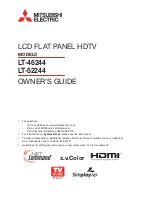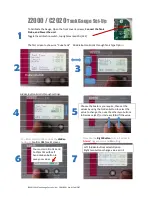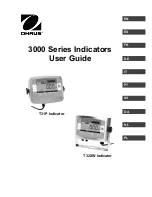
10
1. Television Overview
TV Back Panel, continued
A/V receiver or stereo system, this is the only audio
connection needed between it and the TV.
5. INPUT 1, 2
(Audio and Video)
INPUT 1
and
2
can be used to connect a VCR, Super
VHS (S-VHS) VCR, DVD player, standard satellite
receiver, or other A/V device to the TV. Each TV
INPUT
group consists of jacks for composite video, S-Video,
and analog stereo audio. Note that when you connect
to the S-video jack, the composite video jack is auto-
matically disabled.
INPUT 3
is a third set of composite
video and stereo audio jacks located on the side of the
TV for convenience.
6. HDMI Inputs
The HDMI™ 1.3 (High Definition Multimedia Interface)
supports uncompressed standard and high-definition
digital video formats and PCM digital stereo audio format.
Use the HDMI inputs to connect to CEA-861 HDMI com-
pliant devices such as a high-definition receiver or DVD
player. These inputs support 480i, 480p, 720p, 1080i,
and 1080p video formats, plus PCM digital stereo audio.
Mitsubishi recommends you use category 2 HDMI cables
to connect HDMI 1.3 source devices. High-speed cat-
egory 2 cables bring you the full benefits of Deep Color
and
x.v.Color
.
These inputs can also accept digital DVI video signals.
To connect a DVI source, use an HDMI-to-DVI adapter
or cable plus analog audio cables. Connect the analog
audio cables to
PC/DVI AUDIO INPUT
on the back of the
TV to receive left and right stereo audio from your PC or
DVI device.
The TV’s HDMI inputs are compatible with many DVI-D
and HDMI computer video signals. See chapter 2, “TV
Setup” and Appendix B for additional information on PC
compatibility.
These inputs are HDCP (High-Bandwidth Digital Copy
Protection) compliant.
These inputs are
certified for proper interop-
erability with other products certified by Simplay™.
7. DIGITAL AUDIO OUTPUT
This output sends Dolby Digital or PCM digital audio to
your digital A/V surround sound receiver. Analog audio
from analog channels and devices is converted by the TV
to PCM digital audio. If you have a digital A/V receiver,
in most cases this is the only audio connection needed
between the TV and your A/V receiver.
8. IR Emitter NetCommand
®
IR Emitters connected to this jack are used by the TV’s
NetCommand system to control external IR remote
controlled analog devices such as cable boxes, VCRs,
DVDs, satellite receivers and audio receivers.
9. RS-232 Port
Use this port with external control systems for the
control of TV power, channel, format, volume, and mute.
For detailed information and control codes, please visit
our website at www.mitsubishi.com.
10. CableCARD Slot
Insert the CableCARD™ access card into the slot
located behind the CableCARD access door. When
inserting the card, ensure that the top of the card faces
in the direction indicated by CARD TOP.
If your cable company is not currently offering
CableCARD access cards, use the cable box provided
and authorized by your local cable company to view
scrambled channels.
When using a CableCARD, make sure the incoming
Cable-TV cable is connected to the TV’s
ANT1/MAIN
jack on the back of the TV (Back Panel #2).
HDMI Cable Categories
HDMI cables are available as Category 1 and
Category 2 versions.
•
Category 2 Cables.
Newer, HDMI 1.3-com-
pliant DVD players, video games, and set-top
boxes require Category 2 cables. Use cat-
egory 2 cables for these high-speed HD signals
carrying extended color encodings (i.e., 30 or
more bits, also called Deep Color). Category
2 cables are also suitable for standard HDTV
signals.
•
Category 1 Cables.
Unmarked cables are
category 1 cables and are suitable for standard
HDTV signals, including 1080p signals.
This digital television is capable of receiving analog
basic, digital basic and digital premium cable television
programming by direct connection to a cable system
providing such programming. A security card provided
by your cable operator is required to view encrypted
digital programming. Certain advanced and interactive
digital cable services such as video-on-demand, a cable
operator’s enhanced program guide and data-enhanced
television services may require the use of a set-top box.
For more information call your local cable operator.











































